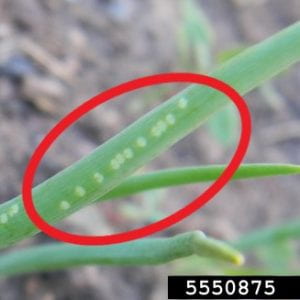Check for Allium Leaf Miner in Onions and Leeks
By Jerry Brust, IPM Vegetable Specialist UME
If you grow leeks or onions or other Allium species, you should already be checking for the tell-tale marks left by Allium leaf miner. Allium leaf miner Phytomyza gymnostoma tell-tale marks consist of many linear small white dots (made by the female’s ovipositor) that appear in the middle towards the end of leaf blades (fig. 1) of their preferred hosts of leeks, onions, garlic and other Allium species. Spring crops are usually not as hard hit as fall crops especially when looking at leeks, but this pest has been steadily increasing its geographical range each year as well as its damage potential. If you had some infestation last year you will especially want to be looking for the signs of this pest.

To go over recommendations for this pest: New transplants or seedings of onions, leeks or garlic should be watched closely for the tell-tale signs of the fly’s damage. When eggs hatch the larvae at first mine leaves (fig. 2) and then move down to the bulbs and leaf sheathes where they feed and eventually pupate. Pupae will undergo a summer aestivation (type of hibernation because temperatures are too warm for them to be active) and only emerge again in late September. You can cover any just-transplanted Allium planting with a row cover (but don’t wait too long after transplanting) to keep the flies off or if needed treat with insecticides. Research out of Cornell University has found using just two applications of spinosad (Entrust, which is OMRI-labelled) two weeks after oviposition marks are first found and then another application 2 weeks after this will give adequate control of the pest. But the oviposition marks must be watched for carefully and discovered very soon after first being made. If new oviposition marks are being seen each week a weekly application of insecticide may be necessary. A penetrant adjuvant also is recommended to be used when treating for the larvae.

